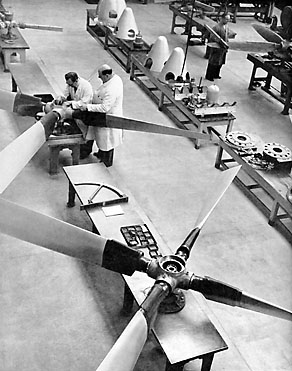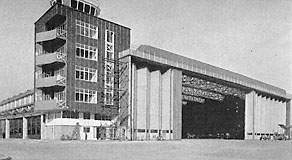
During the Second World War, de Havilland's service centre at Whitby repaired 655 Spitfires and Hurricanes, while the Propellor Division made airscrews and constant-speed gearboxes for the majority of British aircraft. This continued with the supply of propellors for (among others) the Bristol Britannia, Vickers Viscount, and the colossal blades for the SR.N4 cross-channel hovercraft.
As the Cold-War progressed, the Propellor Division diversified into guided missiles, including an air-to-air missile, Blue Jay, known by the RAF as Firestreak and Red Hat, and the ICBM Blue Streak, which eventually became the lifter for the European space rocket. The USAF made use of their expertise, too: in 1961, Comet XM823, which had been fitted out as a flying laboratory during the development of Blue Jay, flew to Edwards Air Force Base to assist with the calibration of the American infra-red targeting system. On subsequent visits, the Comet was used to gather heat signatures for ICBMs launched from Cape Canaveral.
The range of aircraft produced in the 1950s was astonishingly diverse:
In England, de Havilland produced the DH-104 Dove, a twin-engined light transport; the DH-114 Heron, a four-engined feeder-liner; the Airspeed AS-57 Ambassador, a 47-seat, twin-engined luxury liner; and the DH-106 Comet, the world's first jet airliner. The DH-98 Mosquito remained in demand until 1950; while its derivative, the beautiful DH-103 Hornet, was the fastest twin piston-engined fighter of all. The DH-100 Vampire was Europe's front-line jet fighter, manufactured in 4 countries and used by 32 different nations, all over the world. The DH-112 Venom, with twice as much thrust, gradually replaced the Vampire, and was built under license in France and Switzerland. Finally, there was the twin-engined, DH-110 Sea Vixen, a true heavyweight, even by US military standards; it was, at the time, the most potent and sophisticated aircraft in the Royal Navy.
Factories in Canada and Australia, which had churned out Mosquitos during the war, were upgraded with full design and development capability. The DH-C1 Chipmunk was a basic trainer with roots in the original Moth; the DH-C2 Beaver and DH-C3 Otter were the first of a range of tough STOL transports that became popular with both the Canadian and US military, and their descendants are still in production today. In Australia, a special three-engined transport was produced for flying doctors, called the DH-A1 Drover.
This web site celebrates de Havilland's success, their enterprise, and their aircraft.

